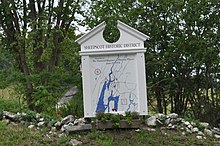Sheepscot Historic District
Description and history
The village of Sheepscot lies astride a narrow point in the upper tidal section of the Sheepscot River, which is the border between the towns of Newcastle and Alna. The main portion of the village consists of a row of closely spaced houses along The King's Highway, one of the Maine's oldest roads, which runs south from the east-west Sheepscot Road on the Newcastle side of the river, just south of the mouth of Dyer Creek. Just south of the junction stands the Sheepscott [sic] Community Church, and there are a scattering of residences on the Alna side. The buildings exhibit a range of 19th-century architecture styles, from the Federal, through the Greek Revival, to the Italianate period.

The area has a colonial settlement history dating at least to the 1630s, and possibly the 1620s, and was before then the site of Native American activity. The Sheepscot area fell between major land grants, one bounded on the east by the Kennebec River, the other on the west by the Damariscotta River. The first bridge spanning the Sheepscot was built here in 1794, and the present bridge occupies roughly the original footprint of that bridge.
See also
References
- ^ "National Register Information System". National Register of Historic Places. National Park Service. March 13, 2009.
- ^ "2003 Maine's Most Endangered Historic Resources". Maine Preservation. Retrieved June 26, 2016.
Further reading
- Greene, Francis Byron (1906). History of Boothbay, Southport, and Boothbay Harbor. Loring.